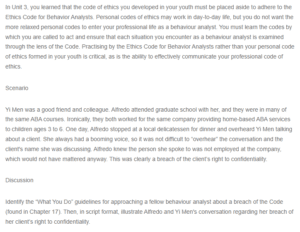What to Do in Case of Violation of Code of Ethics
Bailey & Burch (2016) stated that dealing with another behaviour analyst who violated the code of ethics is easier than with other people since the behaviour analyst is well-informed about the code. In the case of Yi Men and Alfredo, as a fellow behaviour analyst, Alfredo ought to respect Yi (Bailey & Burch, 2016). He can respectfully interrupt Yi Men’s conversation with the other person and excuse himself so that he can speak with her. The next step is asking Yi questions regarding the situation and honestly notifying her that he overheard her talking about a client. He can find out why she is doing that and then present his point of view regarding the matter (Bailey & Burch, 2016). Besides, knowing about the code does not necessarily mean that Alfredo would be competent in helping Yi understand it, even though they are both familiar with the code. Bailey & Burch (2016) state that after identifying the wrong thing that another analyst has done, it is important to know what to say and how it would be said. This is why communicating respectfully and candidly is crucial in this case. Besides, this should not be difficult since the two have a history of friendship and colleague relationships. Alfredo should then present his point on the issue while referring to the code of ethics and then pose a solution like the following conversation. Do you need any help for completing your assignment ? Contact us at eminencepapers.com. We endeavor to provide you with excellent service.
Alfredo: Hi, Yi. Do you mind if I interrupt? May I speak with you for a moment?
Yi: Oh, hi Alfredo, I didn’t see you there… sure. (Excuse me, give me a minute).
Alfredo: I couldn’t help but overhear what you were telling your friend. I don’t want to see you in trouble or something. You know, according to code 2.04, we are only allowed to share a client’s information if granted consent, when there is a threat of harm, contractual issues, crime, or as per the court order (BACB, 2022). So why are you discussing a client with her? Have you revised the code lately?
Yi: Oh, I just wanted to talk to someone and release some pressure I feel at work.
Alfredo: There are other ways we do that; we used to go to that yoga class together. Why did you stop? You could resume seeing a therapist; otherwise, this risks your career.
Yi: You are right. I will contact him.
Alfredo: I couldn’t help but notice that you ordered our favourite Italian shrimp and scallop risotto.
Yi: Yeah. (Chuckles). Come join us.
Alfredo: Oh, thanks, but I’m taking takeouts today. I have to go check on my grandmother, remember?
Yi: Oh yeah, yeah. It’s okay. Say hi to her. And thanks for looking out for me, Alfredo.
Alfredo: Of course.
References
Bailey. J.S. & Burch, M.R. (2016). Ethics for Behavior Analysts, 3rd Edition. New York: Routledge.
BCBA (2022). Ethics Codes. https://www.bacb.com/ethics-information/ethics-codes/.
ORDER A PLAGIARISM-FREE PAPER HERE
We’ll write everything from scratch
Question

What to Do in Case of Violation of Code of Ethics
In Unit 3, you learned that the code of ethics you developed in your youth must be placed aside to adhere to the Ethics Code for Behavior Analysts. Personal codes of ethics may work in day-to-day life, but you do not want the more relaxed personal codes to enter your professional life as a behaviour analyst. You must learn the codes by which you are called to act and ensure that each situation you encounter as a behaviour analyst is examined through the lens of the Code. Practising according to the Ethics Code for Behavior Analysts rather than your personal code of ethics formed in your youth is critical, as is the ability to communicate your professional code of ethics effectively.
Scenario
Yi Men was a good friend and colleague. Alfredo attended graduate school with her, and they were in many of the same ABA courses. Ironically, they both worked for the same company providing home-based ABA services to children ages 3 to 6. One day, Alfredo stopped at a local delicatessen for dinner and overheard Yi Men talking about a client. She always had a booming voice, so it was not difficult to “overhear” the conversation and the client’s name she was discussing. Alfredo knew the person she spoke to was not employed at the company, which would not have mattered anyway. This was clearly a breach of the client’s right to confidentiality.
Discussion
Identify the “What You Do” guidelines for approaching a fellow behaviour analyst about a breach of the Code (found in Chapter 17). Then, in script format, illustrate Alfredo and Yi Men’s conversation regarding her breach of her client’s right to confidentiality.

